

As the market for online courses becomes increasingly crowded, it’s becoming harder to stand out and – with student expectations continuing to rise – it’s also harder to maintain a profitable price point for an ordinary self-paced online course.
Edupreneurs who want to create online courses and sell them need good approaches to bucking these trends and an important one to consider is learning how to create a masterclass.
Yes, it’s true that you will see the term “masterclass” tacked on to all sorts of online content these days – from Webinars to YouTube videos to online courses – but a true masterclass is different. Creators who understand the difference can deliver exceptional value that will attract high-paying students and keep them coming back.
So, in this post, we’ll cover everything you need to know about creating and hosting a true online masterclass.
Let’s dive in.
Looking for the best platform to host a masterclass?
Be sure to check out our coverage of the best online course platforms as well as Webinar platforms that are a good alternatives to Zoom.
What is a masterclass?
But what does the phrase masterclass mean and – especially important for readers here – what is the difference between a masterclass and a regular ol’ course?
At its core, a masterclass is a class in a specific discipline taught to serious students of the discipline by someone who has achieved mastery within the discipline.
Given that masterclasses are often associated with music, I’ll use a musical example to help bring this definition of masterclass to life. If, for example, the world-famous cellist Yo-Yo Ma were to lead a class on tonal techniques for cello students at the world-renowned Julliard School, that would be a masterclass.
Leaving the world of music for the world of sports, if Serena Williams were to offer a class on how to hit a powerful serve (one of her specialties) to a group of top college tennis players, that would be a masterclass.
You don’t have to confine yourself to music or sports, of course – a masterclass can cover just about any discipline – but drawing on these examples, we can identify certain common elements of masterclasses.
A masterclass is a class in a specific discipline taught to serious students of the discipline by someone who has achieved mastery within the discipline.
Jeff Cobb, Learning Revolution
Common elements of true masterclasses
In general, a true masterclass is a class:
- Taught by a true expert
Whoever is doing the teaching needs to have actually achieved mastery of the material that is taught. That doesn’t mean you have to have mastered the entire discipline. You may, for example, be an expert copywriter without having mastered the entire discipline of marketing. Or you may know how to make the best chocolate chip cookie in the world without being much of a baker otherwise. - On a relatively narrow topic
As the examples above suggest, a masterclass is usually going to focus in on a particular aspect of a discipline – tone, for example, rather than everything about how to play the cello; power serving rather than serving in general. In most cases, your students are already going to have solid foundational knowledge of whatever discipline you are working in and they are seeking either to fine tune their knowledge or take it to more advanced levels. Your job is to help them with mastery of a specific area where progress can create high value. To do that effectively, you pretty much have to limit the focus of what you teach. - To highly motivated, focused attendees
A masterclass is nearly always aimed at people who know the basics and are looking to go deeper or get a more specialized view of a topic. To go back to our earlier examples, someone who is interested in how to get the best tone out of cello has probably already spent quite a lot of time learning and practicing. They are ready to stretch themselves to learn more. - Over a limited period of time
In keeping with the narrowness of the topic, the amount of time devoted to a masterclass is usually relatively short. The masterclass might be spread over multiple sessions, but it is time constrained – i.e., you aren’t selling an annual subscription or membership. It’s usually a live event but – with careful instructional planning – it may also be offered through pre-recorded sessions. - With opportunities for feedback
A masterclass is meant to help students advance toward mastery, and you really can’t do that well without receiving feedback as you learn and practice. Masterclasses will typically provide the opportunity to interact directly with the instructor for feedback or with other experts who are capable of supporting and reinforcing the lead instructor’s teachings. They will often also provide the ability for learners – who, after all, tend to be pretty advanced themselves – to interact with and learn from each other, whether through live online sessions, discussion boards, or a messaging system like Slack.
Really, a solid masterclass should have all of the elements above. By comparison, a standard course may lack one or more of them and still be perfectly fine for achieving whatever goals it was created to address. It just won’t be a masterclass.
Masterclass Examples
To tie all of this back to areas that may be more familiar to most Learning Revolution readers, let’s take a look at a range of masterclass offerings.
Mini Launch Masterclass Example
Jeff Walker’s Mini Launch Masterclass is a good place to start. When it comes to online product launches, few people can claim a higher level of mastery than Jeff.
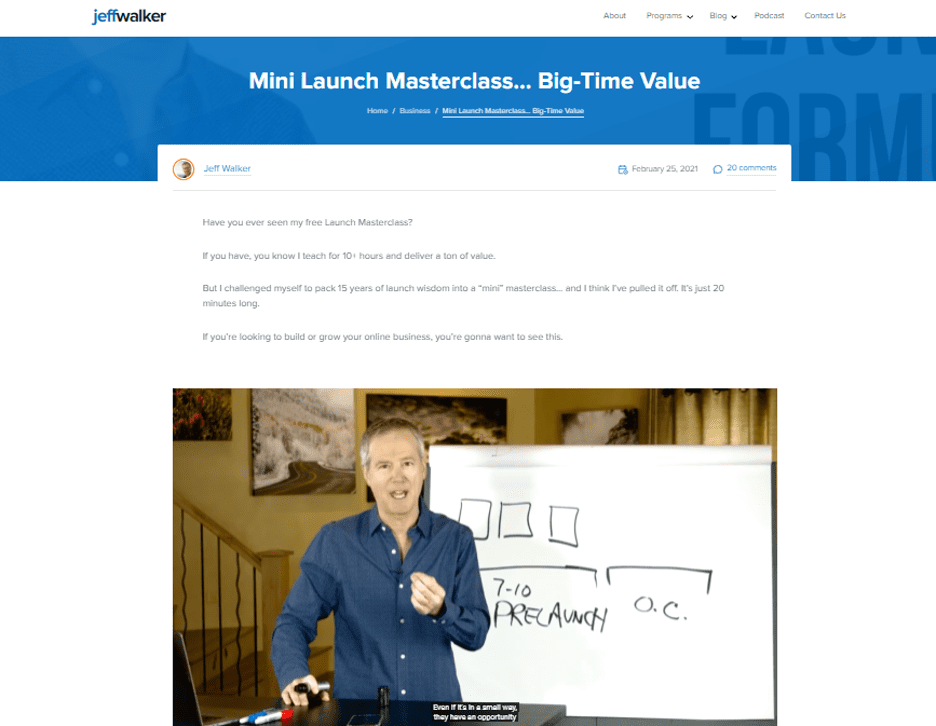

Jeff holds a 15-20 hour long masterclass every year spread over 7-10 sessions. That’s pretty long in the world of masterclasses, but the aim is to cover all aspects of a very niche topic within the much broader world of marketing.
Students who commit to the experience really do take a major step toward mastery. (You can find testimonials along these lines all over the web.) Additionally, while the majority of the content for the masterclass is pre-recorded, Jeff does hold a live – and very valuable – Q&A session as part of the offering.
Heroic Public Speaking Masterclass Example
Next, while we’re focused mainly on online masterclasses here, we shouldn’t overlook in-person as a model. One of my own most powerful learning experiences was in a masterclass offered by Michael Port at Heroic Public Speaking. This was actually an individual experience – just Michael working with me – but it was one that took place in front of an audience of people who could also interact with Michael and learn from everything he did with me.
You can read more about it here, but the upshot was that I had to come to this masterclass prepared with a significant chunk of a speech I was working on. I had to deliver part of the speech and – during a painful number of pauses throughout the process of delivering it – Michael give me really focused, expert advice on how to improve the material and my delivery.
The experience cost quite a bit, but it was invaluable. And, while I clearly got the most benefit from it, I know from talking to many of the people in the audience that they also found it to be a very powerful learning experience. I’ll note, too, that we’ve used a similar sort of “hot seat” model to facilitate mini-masterclasses over the years at Learning • Technology • Design.


The Strategy Masterclass
Another interesting masterclass example is The Strategy Masterclass. One of the reasons to highlight this one is that it narrows its focus based more on the audience than on the topic. The class covers the foundations of strategy – a topic you can find covered in many places – but it does this for a very specific audience: leaders of creative agencies. This narrow audience focus pretty much guarantees a content experience that will be different from the average strategy class, one aimed at mastery of strategy within a specific domain.
As with the other examples already covered, this one also offers students opportunity for feedback. Course creator Jim Antonopoulos hosts regular Q&A sessions with students as well as a live student community.
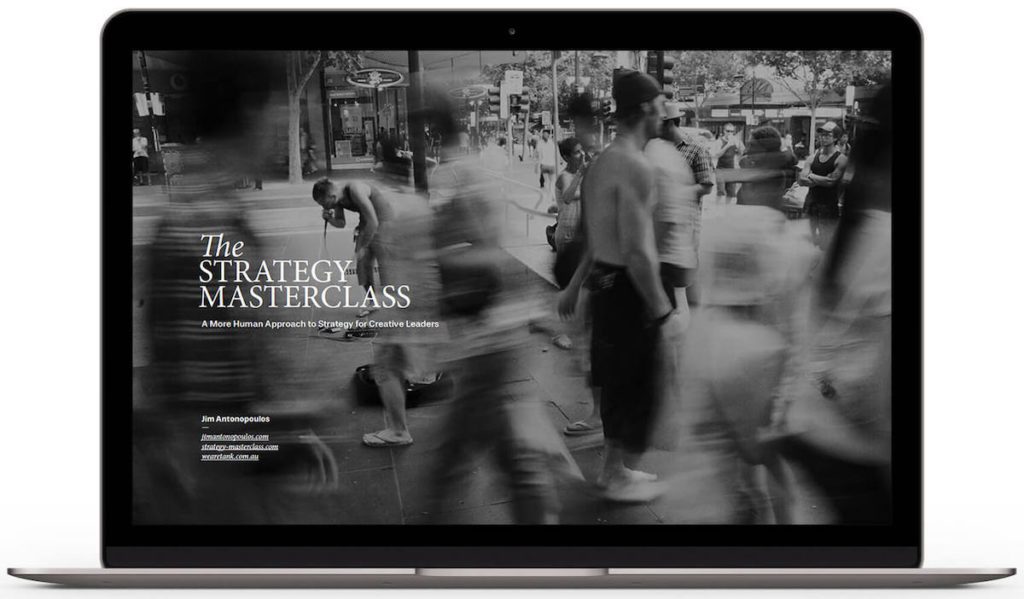

As you can no doubt see by this point, a common theme across these masterclasses is that they carve out a narrow, specialized focus – based on some combination of the content and the target audience – and by doing this, offer a learning experience that goes beyond what you can find in broader, more generic offerings.
| Best Tools To Host A Masterclass |
|---|
Here are my top picks for hosting a masterclass Free Masterclass Hosting Platforms 1 – Facebook Live 2 – YouTube Live 3 – Zoom Premium Live Masterclass Platforms 1 – Webinar Ninja 2 – WebinarJam Premium Masterclass Platforms For Advanced Learning 1 – Thinkific (Full Review) 2 – LearnWorlds (Full Review) |
Why masterclasses succeed
There are three key reasons that masterclasses succeed:
They Are Perceived as High-Value
While the term “masterclass” is often misused and is starting to be overused, it still has the power to trigger a sense of higher quality and specialness in the average human mind. The mere fact that an offering promises “mastery” positions it in a way that can stand it out in an otherwise crowded market and get the attention of your most valuable prospects.
They Are Short and Focused
Students love masterclasses because they are usually relatively short in comparison to a typical course and their intensive nature makes them a relatively easy commitment that delivers rapid results.
Learners who don’t have (or won’t make) the time to commit to weeks-long courses can often find time for a shorter, more intensive experience and will even pay a premium to learn your material in the shortest possible time.
They Enable Deep Connection
The hands-on approach to a masterclass lets you build meaningful rapport and engage with your learners – often your best learners and most valuable customers – seeing in real-time how they parse your instructions and respond to your teaching methods. Needless to say, the bonds and loyalty this can foster are invaluable. Masterclasses can be one of the best paths to cultivating a really dedicated tribe of learners.
The pitfalls of hosting a masterclass
Despite these positives, hosting a masterclass isn’t for everybody. Why?
You Need to Be An Expert
Yes, it’s true. While you don’t have to be the world’s expert in your topic, you do need to have fairly deep expertise, and, perhaps more importantly, you need to be committed to distilling that expertise to what is most essential for your students.
You Need to Answer Live Questions
While delivering at least some of your master class live isn’t absolutely required, unless you have a personal brand similar to the teachers on the Masterclass Web site, being able to interact with you in real-time will likely be a big selling point for the course. (And, in my opinion, Masterclass classes aren’t really masterclasses – they are just well-produced lectures.)
So, you have to be comfortable interacting with learners in a real-time environment and you have to be fluent enough with your content to adjust on the fly as you address student needs and questions.
Students Have High Expectations
Finally, as already hinted, the master of masterclass is an important consideration. Learners expect masterclasses to be taught by high-caliber experts. That doesn’t mean you can’t begin your edupreneurial career by teaching a masterclass, but if you’ve already made a name for yourself in your field, attracting learners will be considerably easier.
Regardless, you are going to need to be able to legitimately present yourself as having the experience and knowledge expected in the leader of a masterclass.
How to tell if teaching a masterclass is right for you
If you’re the kind of educator who enjoys leading a group and can communicate effectively on the fly, teaching a masterclass could be the ideal next step in your career.
Edupreneurs who do well with masterclasses are usually (though not always) engaging speakers, and they are always knowledgeable and passionate about their subject. They are able to guide learners quickly through the basics in such a way that a relative novice can leave the masterclass feeling accomplished, and an advanced student still feels like taking the class was a sound investment.
If that sounds like you, read on and learn everything you need to know about how to plan, market, price, and host a masterclass.
How to plan an online masterclass
Much of the planning for a masterclass will be similar to other online courses, but you will want to make sure your topic and your delivery methods are a good fit for this approach.
Choosing a subject for your masterclass
Before you start writing your masterclass, think about what you intend from it.
Find Your Purpose
By purpose, I mean what are you going to get out of it. That could be another revenue stream, a way to boost your reputation, or simply a fun experiment. Your reason for wanting to run a masterclass is entirely personal—there’s no right or wrong motivation—but whatever that reason is, it will inform the way you plan your masterclass, so be honest with yourself about what you really want to achieve.
Be clear, too, about where your purpose aligns with where you really have the knowledge and/or skills to go deep with students in a focused area.
What’s In It for Students
The second consideration when planning your masterclass is its goal. What are the learners going to get from it? What knowledge or ability will they have at the end of the masterclass that they lacked at the beginning, and how will it impact their lives?
These two considerations might seem similar, but between them, they will form the basic premise of your masterclass.
For example, if your purpose is to increase your income, you need to offer your learners a chance to attain a goal that they will pay more to achieve. If you want to boost your reputation in your field, you might choose to focus on an advanced subject with a limited appeal but more prestige.
Consider your purpose and goal in relation to each other. Are they complementary, or will they produce opposing results?
Who’s Your Audience
Your final consideration is your audience. Who can you plausibly reach that will be eager to participate in a masterclass on your topic and how much – if anything – might they be willing to pay?
A $5000 masterclass may fly with C-suite execs or successful entrepreneurs, but it clearly it won’t work well with broke graduate students. If your target market is the execs or entrepreneurs, you won’t need to sell all that many seats for a masterclass to be a profitable offering. If your audience is closer to the broke graduate students, on the other hand, you’ll need to make sure you can reach a lot of them. And, your offering will either need to be relatively low-priced and/or serve other purposes – like indirect revenue generation or brand building – for your business.
By considering these three factors, you should be able to answer a lot of questions about the subject of your masterclass.
Creating your masterclass
When it comes to designing and writing your masterclass, keep in mind that this isn’t a speech or a typical seminar. You won’t need to write out every word, but you should have a clear of the structure for the class, the desired outcomes, and what you’re going to say to guide your learners to their desired outcome.
What you actually do and say in the masterclass will, of course, be guided by the specific topic and the outcomes you aim to help your learners achieve. If you’re teaching an art masterclass, for example, your target outcome might be for your learners to complete a painting. In that instance, you’ll be leading by example, describing techniques as you use them, and won’t need to write any long speeches.
On the other hand, if your masterclass is on the history of art in the Renaissance, you’ll need to plan your words much more thoroughly and you may need to coach your learners in writing effectively about art.
As the examples suggest, you’ll need to consider the types of actions that learners will need to take in the class and the types of materials and interactions that will be needed to support them. Masterclasses are usually intended to be more interactive than other online learning formats, so don’t forget to include plenty of space for learners to ask questions or get feedback. This ensures that all your learners are keeping up with the material and have the opportunity to shape it to their needs.
In general, while masterclasses may often have a more fluid, less formal feel to them than more structured online courses, all of the elements of good online course design still apply.
How to host your masterclass
With your business and learning goals clearly defined, you can begin to consider where and how host your masterclass.
If your masterclass is going to consist primarily of live online sessions, perhaps supported by some supplemental documents, then you may need little more than e-mail, and simple e-commerce solution like PayPal, and a Webinar or live video streaming platform.
(Tip: A platform like WebinarNinja combines great interactive tools with e-mail marketing and paid registration through Stripe integration – a much more complete package than you get with standard options like Zoom.)
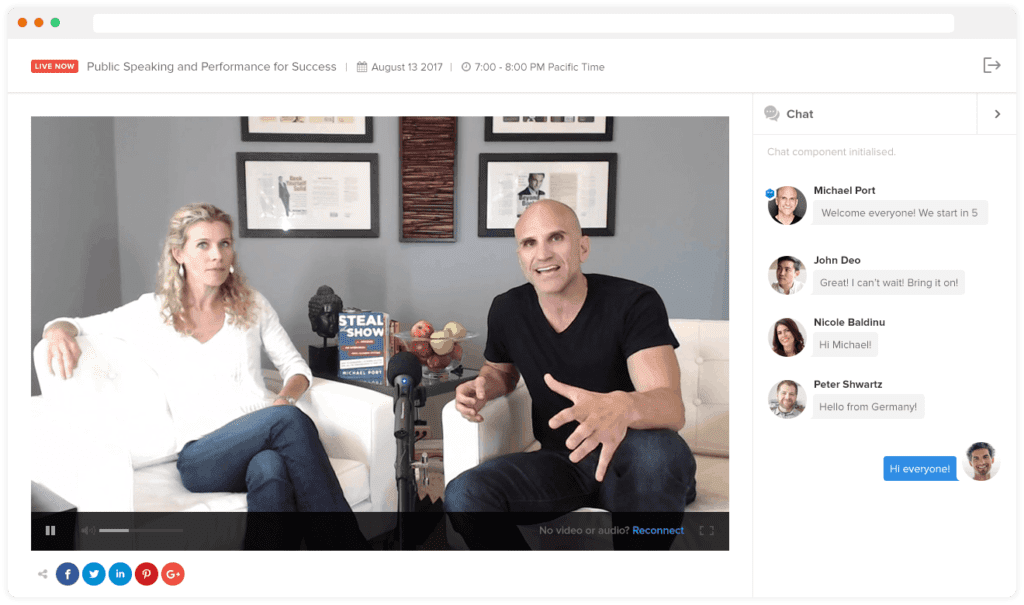

If, on the other hand, you want to blend live online sessions with more substantive on-demand content – like, for example video tutorials, discussion forums, or assessments – then you will definitely benefit from using a platform like Thinkific, LearnWorlds, or one of the other online course platforms I cover here.
In general, don’t over think it.
You can run an online masterclass with simple tools and even free tools – like, for example, a combination of Facebook Live and a Facebook group. But also be aware of your audience’s perceptions. In general, prospective learners are going to expect and appreciate a certain level of professionalism from anything called a “masterclass” and both your communications about the offering and how you host it need to reflect that.
More on how to plan an online masterclass >>
6 Steps to Launching A Masterclass
Once you’ve prepared the content for your masterclass, it’s time to attract leads and convert them into customers by communicating the value of your event.
There’s no better way to do this than email marketing because it allows you to nurture your leads and gradually move them towards conversion.
So, if you already have a large email subscriber base, your job becomes much easier. But if you don’t have an email list, you’ll need to set up a sales funnel for your masterclass.
Either way, here’s a series of steps you need to follow to successfully launch your masterclass.
1. Create A Lead Magnet
A lead magnet is a free resource such as a PDF eBook, video training, cheatsheet, checklist, etc., that your website visitors can download by entering their email address.
To attract the right leads for your masterclass, you need to create a lead magnet that not only aligns with their interests but also gives them an idea of the value you’re offering in your masterclass.
And it doesn’t need to be a huge resource either.
You could easily create a 3-4 page document, design it for free using Canva, and offer it as a free PDF to your visitors. Or you could opt for more advanced lead magnets like live training or webinars.
For example, if your masterclass is about building a seven-figure online course business, your lead magnet could be a live or recorded 20-min sample class on building a winning online course.
Here’s a good example.
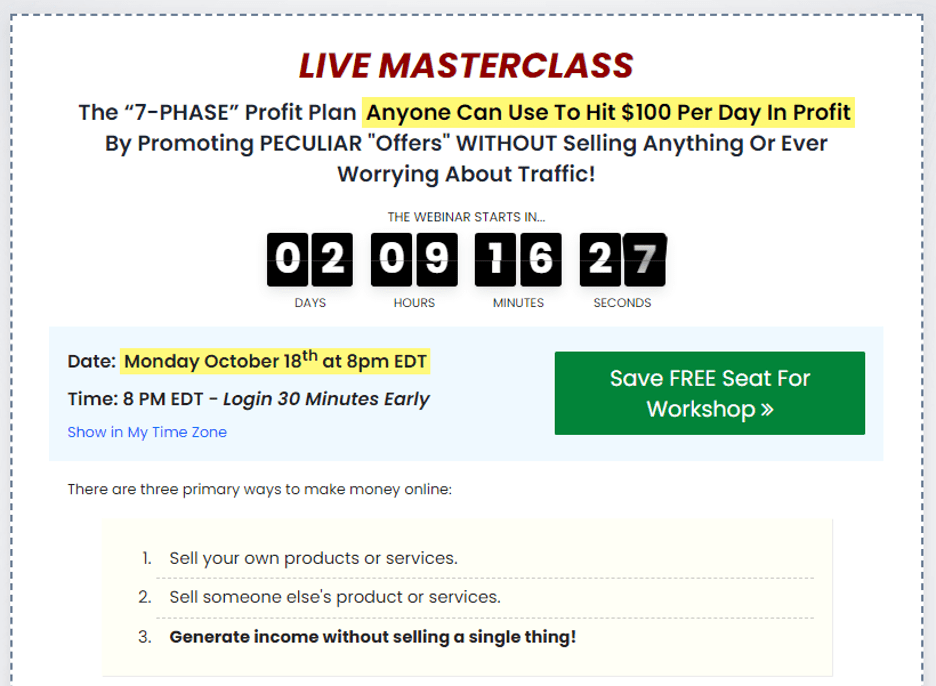

Similarly, you could offer an eBook or a strategy blueprint to share high-level information with the users and attract them to your list.
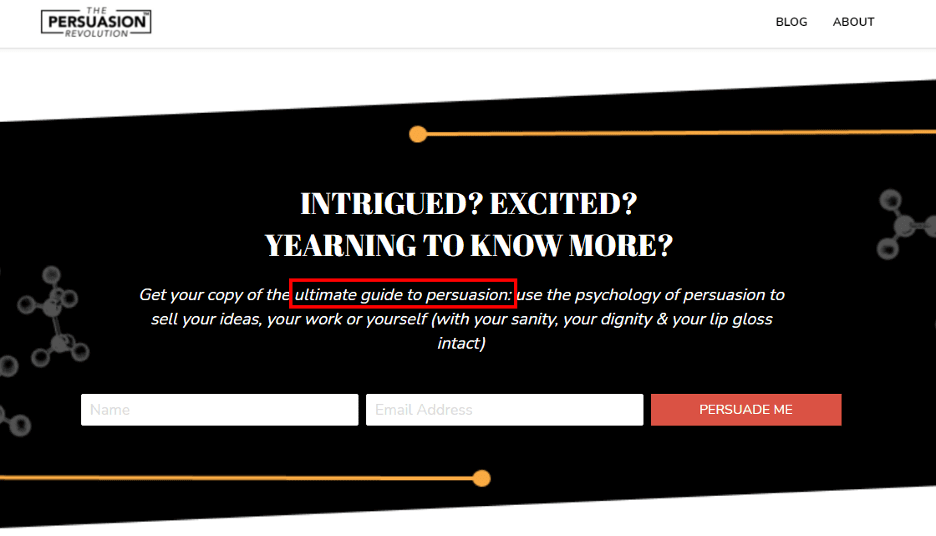

Or you could offer a free webinar that provides your visitors a limited inside look at your premium masterclass.
For example, Anton Kraly of Dropship Lifestyle uses a free training session to attract subscribers to his list.
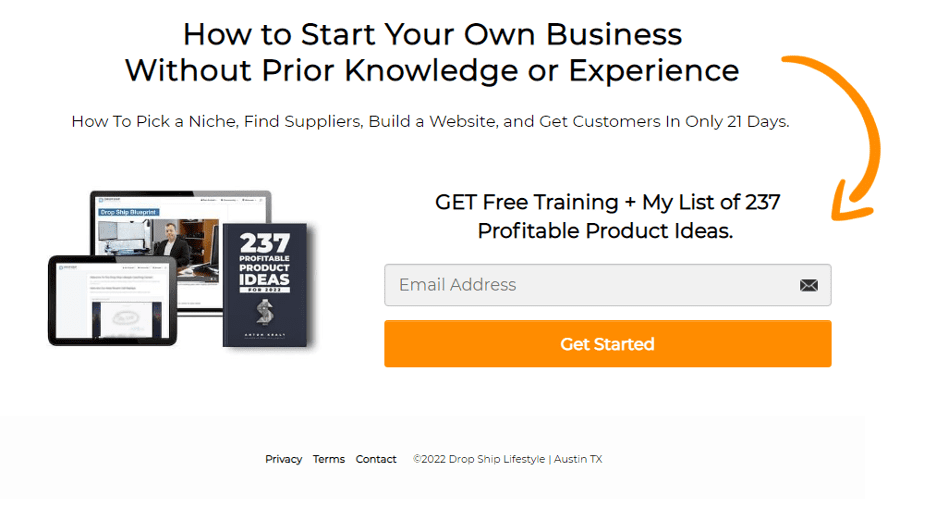

Whichever lead magnet type you choose, you need to ensure that it has the following qualities to attract the right subscribers.
– It must be an extension of your premium offer. For example, if your masterclass is about building a design agency, your lead magnet should be related to it.
– It should address an urgent and well-defined problem. For example, in the above screenshot, the free training is accompanied by a list of 237 product ideas.
– It should be easy to consume. For example, a 200 page eBook on “how to start blogging” is not an attractive lead magnet. In comparison, a three-page checklist on monetizing a blog is an excellent lead magnet because it provides immediate bite-sized information to your prospects.
– It should provide instant gratification. For example, a training session scheduled after 3-4 days won’t attract many subscribers. In comparison, a short video training that’s immediately accessible is more enticing for your prospects.
In short, your lead magnet should be relevant to your core offer and easily accessible so that you only attract relevant subscribers who’re interested in your masterclass.
Once you create a lead magnet, move to the next step.
2. Setup Your Masterclass Landing Page
You need a landing page where you can place your lead magnet with an email opt-in form. When you route visitors from your email list or ads to this landing page, they’ll be able to sign up for your lead magnet using the opt-in form.
Why use a lead magnet landing page instead of directly selling your masterclass?
Because research shows that, on average, it takes around 8 customer interactions to close a sale. If you pitch your masterclass directly, you’ll only get one interaction with your prospects which significantly lowers your chances of driving sales.
But once someone signs up for your email list, you get their permission to send unlimited messages to their inbox. This is why email marketing has an ROI of $42 for every dollar spent.
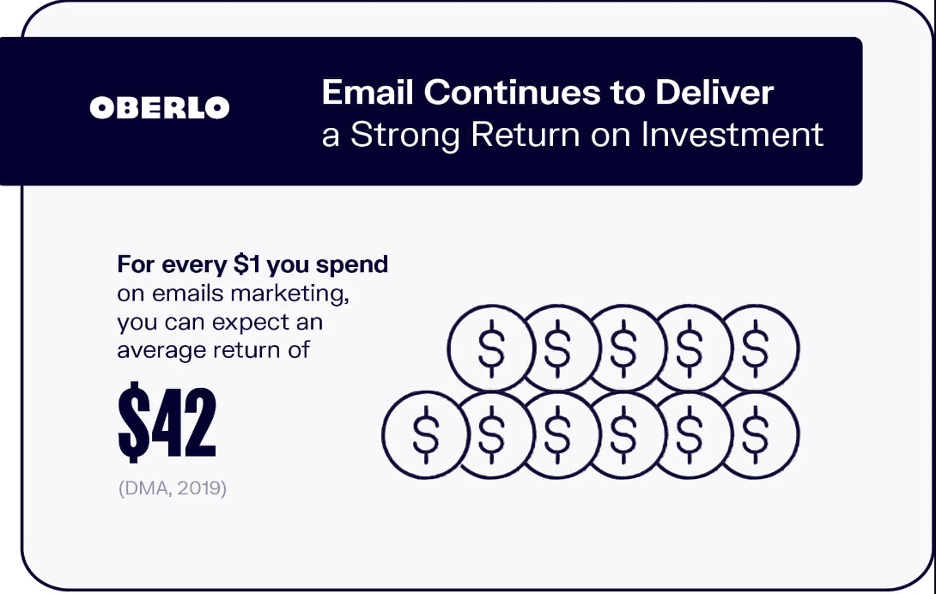

Plus, you can use Facebook and Google Ads retargeting scripts on your landing page. This allows you to run advertising campaigns targeting the visitors that bounce off your landing page without signing up for your lead magnet, giving you additional touchpoints.
So what does a good landing page look like?
Here’s an excellent example.
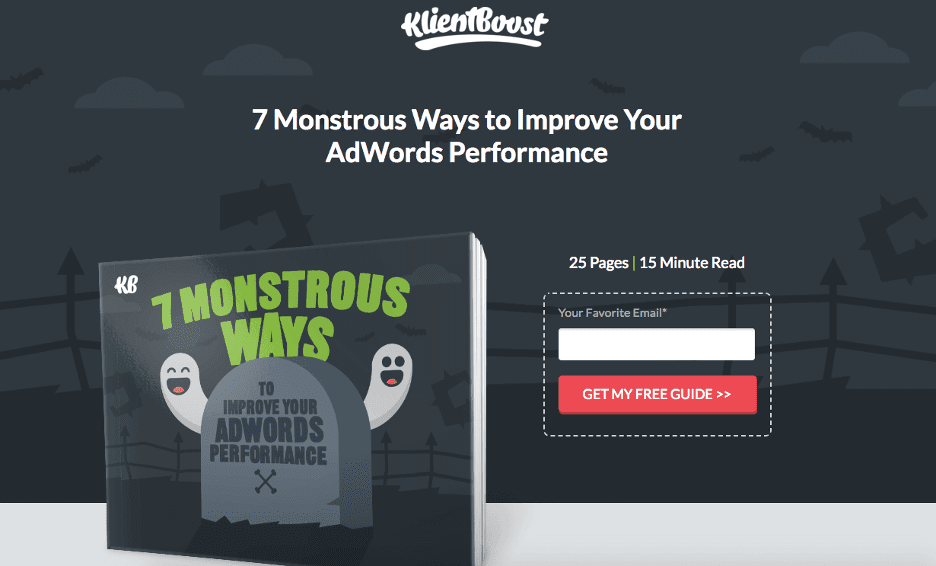

Here’s another example.
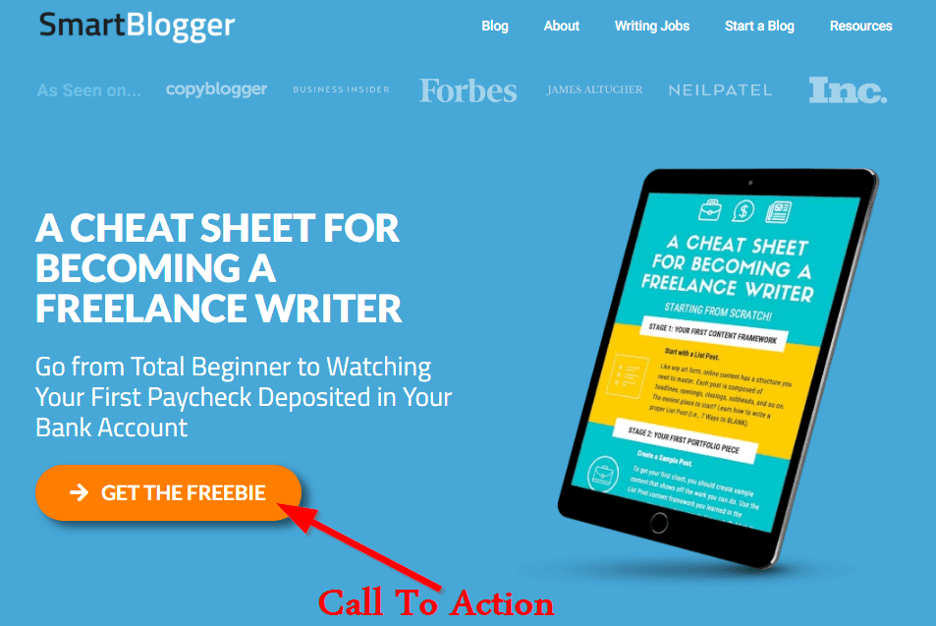

The goal of your landing page is to convert your visitors into subscribers by persuading them to download your lead magnet and sign up for your email list.
To achieve this goal, you need to do the following.
– Use an enticing headline that highlights the core offer in your lead magnet and compels the visitor to sign up.
– Use an attractive image of your lead magnet to visually appeal to your visitors.
– Use a sign-up form
– Add an optimized Call To Action (CTA) button.
– Integrate your landing page with your email marketing software.
– Set up an autoresponder to deliver your lead magnet once a subscriber signs up.
If you’re hosting your masterclass on Zoom or Facebook LIVE, you’ll need to set up a landing page using landing page software like LeadPages or InstaPage to get all the integrations right.
But if you’re using Thinkific for your masterclass, which I recommend, or any other online course platform, you’ll be able to create a lead magnet landing page using their drag & drop site builder tool.
3. Announce Your Masterclass to Your Existing Audience
Now that you’ve created a lead magnet for your masterclass and have your landing page ready as well, it’s time to start marketing it to your target audience.
But before using ads and other marketing techniques, announce it to your existing audience.
You might already have an email list with a few hundred or a few thousand subscribers. They already know you and have been consuming your content.
But to ensure that they’re a good fit for your masterclass, email them about your new lead magnet with a link to your landing page (make sure you create a separate list or segment for the subscribers from this landing page in your email marketing tool.)
This way, you’ll be able to filter out the subscribers who are likelier to purchase your masterclass offer.
Once they sign up to your email list, you’ll add them to your autoresponder email sequence that nurtures and moves them close to the eventual sale.
What’s an autoresponder series? Let me explain in the section.
4. Create An Email Autoresponder Series
An autoresponder is an automated email sequence triggered by your audience’s actions. It allows you to personalize your email marketing and tailor your messaging to your audience’s needs.
For example, when you email your subscribers, you can create a different follow-up email for the users who open your email and click a link in your message than those who don’t.
Why do you need an autoresponder?
Because once you convert your landing page traffic into subscribers, you need to send them a series of emails persuading them to sign-up for your paid masterclass.
These emails can be automatically sent every 2-3 days (or whatever schedule you decide.) You can create specific follow-up emails for the subscribers who don’t open your first email.
The ones that do are automatically moved to the next stage of the autoresponder.
Here’s an example of a condition-based email sequence.
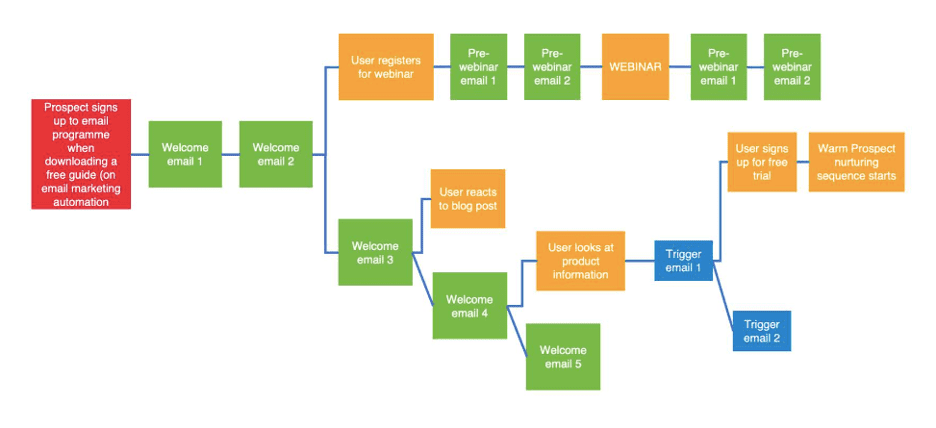

As you can see, this is a post lead magnet sign-up email sequence that caters to different types of users based on their actions.
So what kind of email sequence should you create?
You can only find the answer to this question by performing audience research. But since you’re using a lead magnet to sign up users for your paid master class, here’s a sample email sequence you can send your subscribers to warm them up for the sale.
Email #1: Welcome email with a link to your lead magnet
Email #2 [Next Day]: Follow up to ask if the readers explored the lead magnet and had any questions.
Email #3 [2 days later]: Share a success story of someone who followed your advice and changed their business/life.
Email #4 [2 days later]: Share free actionable advice.
Email #5 [2 days later]: Identify a common mistake and suggest the right path.
Email #6 [2 days later]: Soft sell by sharing insights from your masterclass, share a student’s success story.
Email #7 [2 days later]: Announce your masterclass and share the sales page link
Email #8 [Next day]: Share success story, link to sales page.
Email #9 [Next day]: Doors closing, last invitation with a special offer (installment plan or additional training.
Email #10 [Next day]: Final hour countdown.
Email #11 [Same day]: Share what they missed out on and add them to your regular content email list.
This is just a sample email sequence to give you an idea of what it looks like.
How can you create these email sequences? By using an email marketing software such as GetResponse, ConvertKit, ActiveCampaign, MailChimp, etc.
All these tools offer marketing automation and segmentation features. But I prefer ConvertKit because of its ease of use and robust features.
Create An Email Sequence With ConvertKit For Free
5. Develop A Facebook Ad Campaign
You’ve created a lead magnet, placed it on a landing page, and setup an email autoresponder for your subscribers, it’s time to start driving traffic.
This is where Facebook Ads come in.
You’ve already announced your lead magnet to your existing email subscribers. Now Facebook Ads will help you attract new subscribers.
Facebook provides you an easy to use advertising platform with better audience targeting features than most other ad networks.
This is why millions of marketers use it to drive traffic to their lead generation campaigns.
Here’s an example of a Facebook ad promoting a lead magnet.
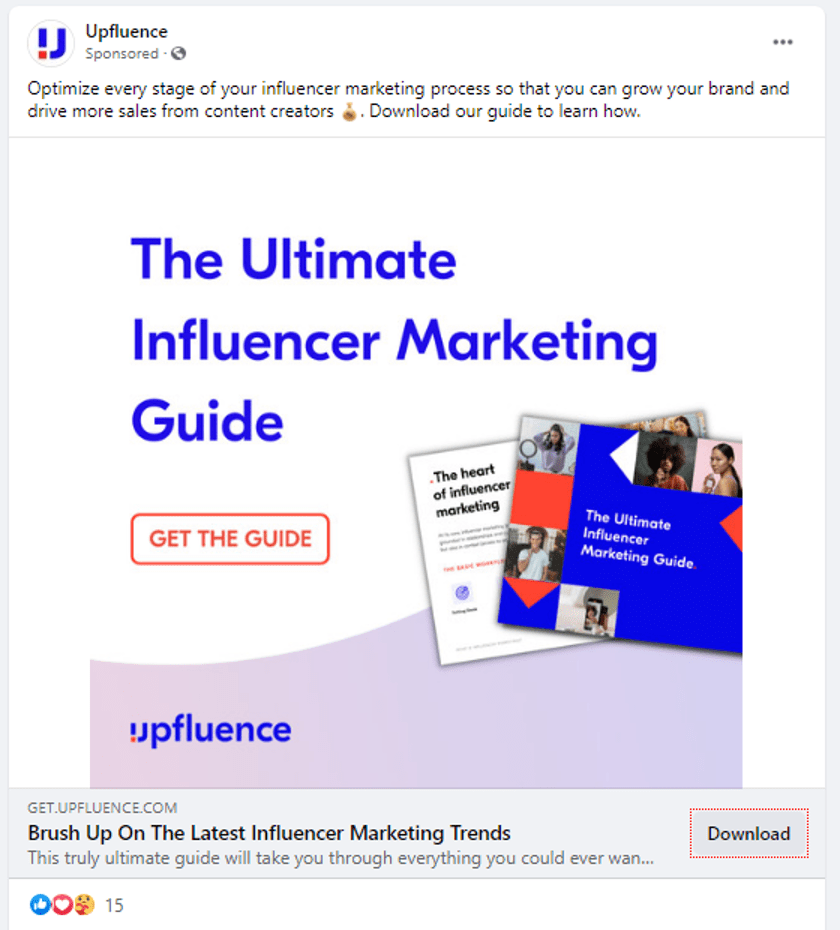

When you click on the Download button in this ad, it takes you straight to its lead magnet landing page where you can sign up and download the guide.
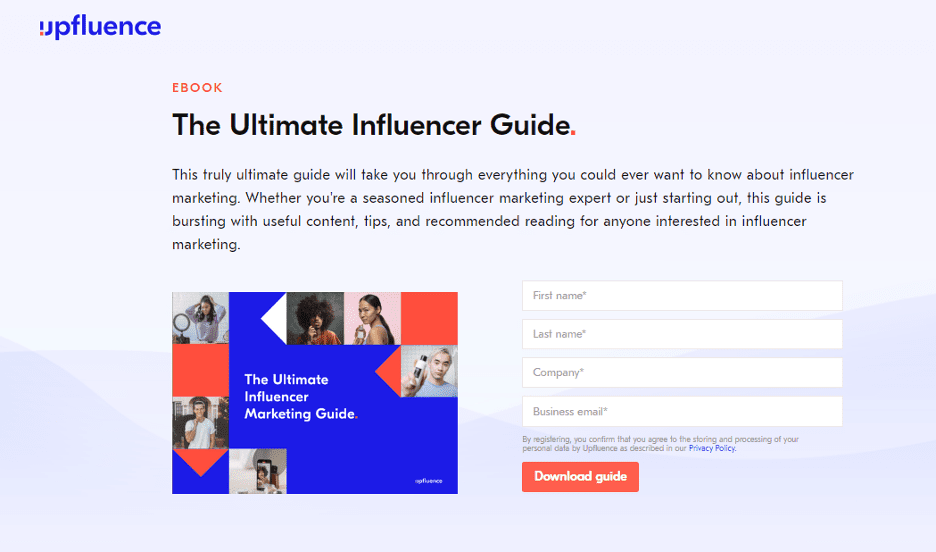

Similarly, here’s another Facebook ad promoting a lead magnet.
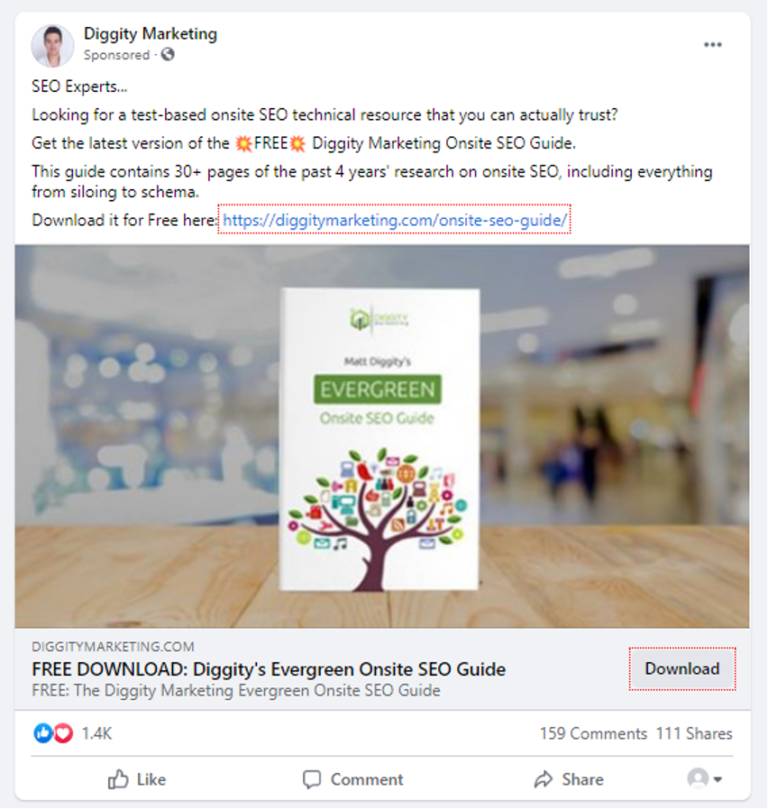

Clicking the download button takes you to the lead magnet’s landing page and also signs you up for an email autoresponder series, as I described in the previous point.
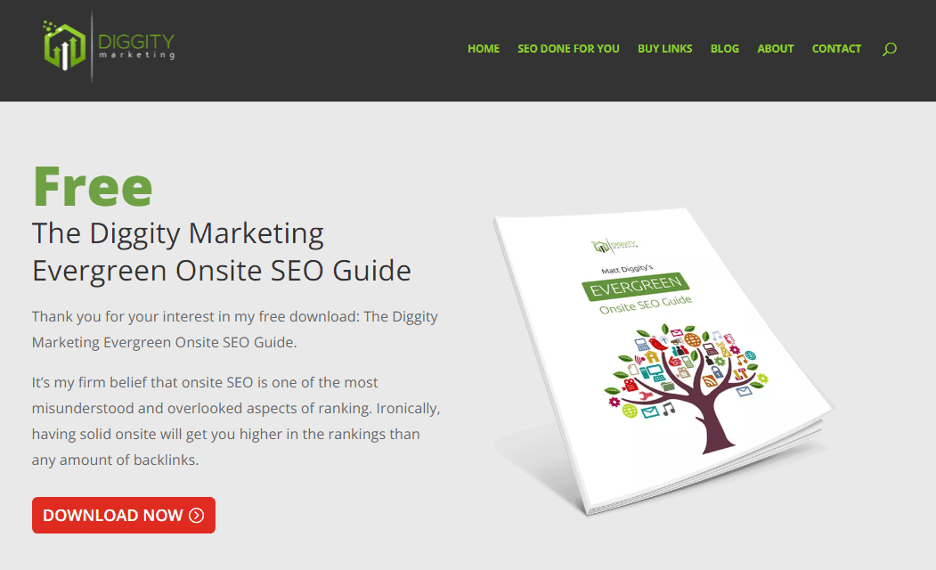

So, how do you create a Facebook ad?
It’s a simple but lengthy process that I can’t describe in a few lines here.
So I’d recommend reading this detailed step by step guide for creating your first Facebook ad.
Start your first campaign with a small budget of $5-10 to analyze the results before scaling. Because if you’re not careful at the start, you can end up burning hundreds of dollars without any results.
Only invest more money in ads when you get your targeting right and start generating traffic to your page.
6. Sign Up Students For Your Masterclass
When you switch on your Facebook ad campaign, you’ll start getting traffic to your landing page. You might think your job is done by now, but it’s not.
You need to keep a close eye on the traffic to leads conversion of your page to ensure that it is perfectly optimized to gather subscribers.
Because if your landing page isn’t optimized, the referral traffic from Facebook ads won’t convert into email subscribers.
Research shows that the average landing page conversion rate across all industries is 2.35%. Which means only you get 2.35 subscribers for every 100 visitors to your landing page.
But those are just the average figures. You should be aiming for at least 5% to 8% conversions for your landing page since that’s the rate for the top-performing landing pages.
If you want to learn more about optimizing your landing page for conversions, I recommend reading this article.
This step completes your masterclass launch sequence.
Once you start getting subscribers through your lead magnet landing page, they’ll start getting your email sequence designed to convert them into customers.
And when your subscribers sign up as customers, you can add them to your premium masterclass session.
Again, you can do all of this using free tools but that’s going to be a lot of work.
Which is why I recommend using Thinkific for hosting and managing your masterclass, and ConvertKit for email marketing automation.
How to price an online masterclass
Pricing your masterclass is an important factor in ensuring you attract not only enough learners, but also the right learners – a critical component in the success of any masterclass.
I don’t ever advocate cost-based pricing – i.e., (Costs + your time) / number of attendees = price – but this is a case where it is especially undesirable. A masterclass is all about the unique value that you can provide and the multiples of that value – the high return on investment – that your learners will get from interacting with you.
Yes, you obviously want to cover your costs, but your price should suggest the level of value you feel you can help your learners achieve and it should also reflect where a masterclass sits relative to other products and services you offer. A useful tool for thinking through this is the Value Ramp I developed with my company, Tagoras.
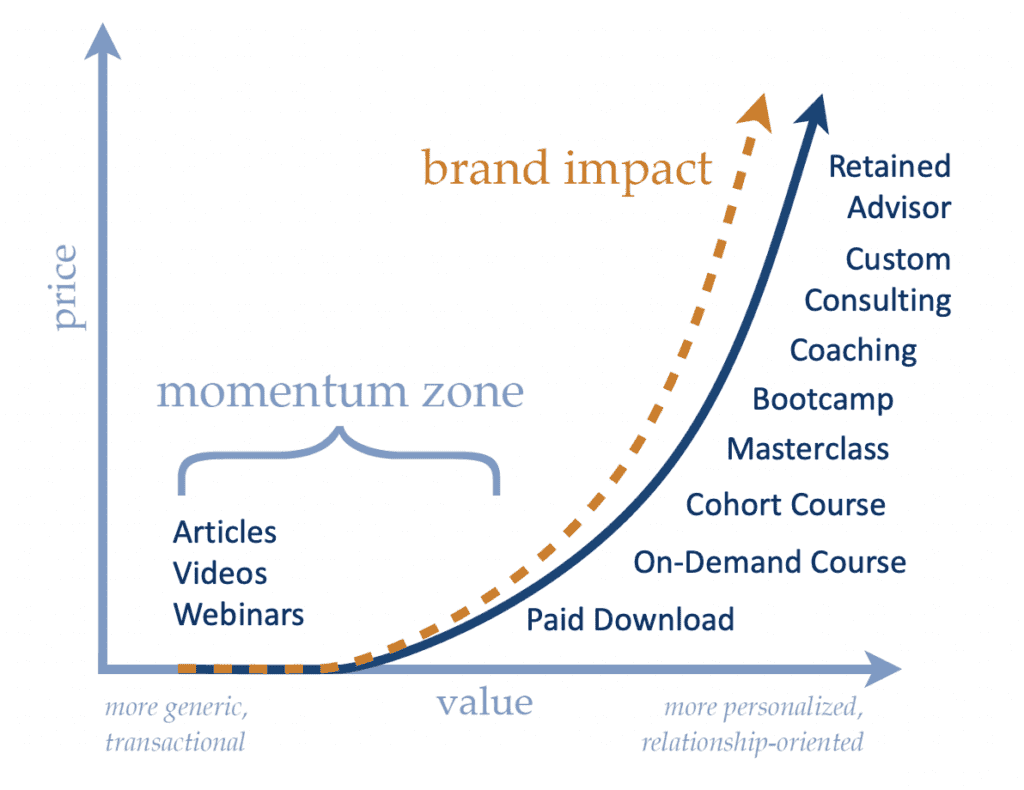

I’ve written much more about the Value Ramp in another post, but the key point here is that there is a relationship between price and value when it comes to selling just about any product of service. Provide more value in the eyes of the potential purchaser, and you can and should charge more.
Your masterclass is an offering that will typically fall in the upper half of your Value Ramp, above things like eBooks or on-demand courses. So, you should price it accordingly.
As a very generic rule of thumb, I usually don’t want to see a masterclass priced below $997, and usually $1,497 or above is a better starting point. If that sounds like a figure you can’t achieve, revisit my posts on topics like elevating your expertise and building your audience. Your goal is to get to a point where you can charge at this level.
And by the way, if you are taking a current face-to-face masterclass and shifting it online, do not drop the price unless there is some clear way in which you are not providing the same value online. Chances are good that you are providing the same value (at least if you have designed your offering well). And that’s the whole point of value-based pricing: neither the format nor the underlying costs matter. It’s the value you produce that matters.
More on how to price a masterclass >>
Getting sponsors for your masterclass
Having said what I just said about pricing, there can be situations where charging at a high level is challenging, if not impossible.
If, for example, you’re planning to teach learners with limited funds but don’t want to compromise your income, finding sponsors may be an option. Sponsors can provide anything from cash in exchange for advertising to the equipment and technology required to host the class.
Obviously, you don’t want to turn your masterclass into an infomercial for another company, so think carefully about who you approach for sponsorship. Relevant companies might include suppliers of products related to your subject, or businesses who employ workers with the skills you’re teaching.
Consider your target learners again. What demographics do they fall into, and what brands most want to reach those demographics? You could strike a deal with a completely unrelated company if you can demonstrate an overlap between your learners and their target audience. Just like non-sporting companies such as Verizon and Budweiser sponsor the Super Bowl, you can encourage seemingly unrelated companies to sponsor your event if you can demonstrate why it would be to their benefit.
If you go the sponsorship route, be absolutely sure to communicate to your learners that whatever they end up paying for your masterclass (including attending free) is possible because of the generosity of the sponsor. Indeed, my strong preference is to never publish anything other than your ideal target price for the course and to provide any price breaks only through scholarships (underwritten by the sponsor) or codes you distribute to qualified attendees.
More on how to get sponsors for your masterclass >>
How to promote your online masterclass
Naturally, in order to sell seats, you’ll have to promote your masterclass. You might be lucky enough to already have a strong following, and a simple announcement on social media or your website will be enough for your masterclass to sell out. If that isn’t the case, it’s time to think about your target audience and how best to reach them.
The promotional period falls into three key stages: before your masterclass launches, during the sale period, and after it has sold out (yes, really). Here’s how to promote your masterclass for the best results.
Before you launch your masterclass
Your first step is to gauge interest and make as many contacts as you can that you can later convert into sales. Starting this process early means you can identify mistakes you’re making in the planning of your masterclass before it’s too late to change them. It’s never too soon to learn that you’re targeting the wrong market, or trying to sell a goal when there’s no demand.
Reach out to your existing networks. This could be your social media followers, website subscribers, past learners, or professional contacts. Poll as many people as you can to see where interest lies. If you start this stage as soon as you begin planning your masterclass, you can even ask for ideas about the class subject and discover what people most want to learn.
If you don’t already have an email list, start one and encourage interested learners to sign up. Even if you do have a mailing list, consider creating a separate list in order to later make a sales funnel with those warm leads. (Again, all my usual preaching about building an audience applies.)
During your masterclass sales period
The most important time for promotion is when your masterclass places are available. Promoting during this period is easier because you can convert leads into sales immediately, rather than relying on them remaining warm until tickets become available.
Online promotion is the fastest and most cost-effective way of reaching the largest number of people. Start a sales funnel with your mailing list to announce that the masterclass is available, and give them a direct link to where they can register. The more clicks it takes to reach the sales page, the more people will drop out of the process, so make it as easy as possible for interest to convert into sales.
Remember that urgency is a powerful tool in a seller’s arsenal, so don’t hesitate to use it in your promotional efforts. That’s why it’s a good idea to limit the spaces in your masterclass, and only make them available for a short period of time. This drives the learner to purchase or risk losing out, so emphasize these limitations on availability, and be sure to announce milestones as places start to sell out.
After your masterclass has sold out
Once your promotions have paid off and your masterclass has sold out, you might be wondering about the point of continuing to promote your class. However, there will still be learners who are interested in your masterclass but remained on the fence until it sold out.
Perhaps they weren’t in a good financial position to attend this time or had a commitment on the date of your class. They could be undecided about whether or not it was really worth the money, or they might have simply forgotten to buy the tickets in time. Whatever their reasons, you’ll probably find you have a number of people who are still interested in your masterclass even after it has sold out.
Engaging those people and keeping their interest is a great way of setting up a new sales funnel if you want to repeat your masterclass or host a different one at a later date. Use your mailing list and social media and/or website to create contact points where interested learners can keep tabs on what happened in your masterclass and how learners responded.
There are any number of ways you can keep your online masterclass in your followers’ minds and continue your promotional efforts. Depending on the nature and subject of your masterclass, you could encourage learners to share updates online during and after the class (for instance of the artwork they’re creating, or an experiment you conduct). You can collect these social mentions by suggesting the use of a hashtag for your event, and even build it into your promotional efforts ahead of time.
Keep a recording of your masterclass that you can repackage after the event. Curate sharable images and short video clips that make your masterclass look fun and engaging. And, of course, don’t forget to encourage attendees to tell their friends and/or professional colleagues about your masterclass and leave reviews. All of these efforts heighten your presence, boost your reputation, and increase the sense among onlookers that they missed out on something special. This ensures that next time you offer places for a masterclass, you’ll have more learners eager to attend.
More on how to promote your masterclass >>
Assessing the success of a masterclass
Once your masterclass is over, it’s worth reflecting on how it performed. Did you fulfill your purpose? Did your learners achieve their goal? The metrics you use to determine the success or failure of your masterclass will depend a lot on the reasons you hosted it to begin with, but here’s some factors to consider.
Short- and long-term outcomes
Each set of considerations can be reviewed in both the short and long term. If the masterclass sold out and turned a profit, that’s a short-term goal achieved. But can it continue to generate revenue? If so, that’s a long-term success.
There are three key factors you can consider when evaluating the outcome of your masterclass:
- Financial success
- Learner satisfaction
- Learner outcomes
The financial success of your online masterclass is probably your most important consideration. That can come in a number of different ways, from turning a profit on the day of the masterclass, to paving the way toward ongoing revenue through repeat masterclasses and monetization in new formats (more about this soon!). A masterclass can also boost your reputation in your field and bring in new income through other opportunities, such as brand partnerships, speaking engagements, or the chance to increase the price of subsequent classes and other courses.
Learner satisfaction and learner outcomes might seem to go hand-in-hand, but it’s possible to produce very different results between the two. Learners might achieve their goal of mastering the class subject, but if they found you abrasive or hard to follow their satisfaction level could be low, despite getting what they wanted from the class. Equally, you could fail to teach the outcomes you promised but succeed in other ways, leading to higher levels of satisfaction despite the masterclass falling short.
Gauging learner satisfaction is fairly straightforward. In the short term, check out reviews and online discussion about your course. Are learners leaving recommendations? Silence probably isn’t great news, but an absence of reviews or feedback isn’t necessarily a disaster. Reviews are prompted when people feel moved by extremes (love/hate), so while getting few or no reviews suggests you have more work to do to really engage your learners, you can be pretty sure they didn’t think your masterclass was terrible.
Longer term, look how your other courses and classes perform. Are learners from your masterclass signing up for your other products, or do you never hear from them again? Was there an unexpected boost in sales of your ecourses, more sign ups to your mailing list, or an increase in visitors to your website? These are all good long-term indicators that your masterclass has generated ongoing interest in your teaching.
Keeping in touch with your learners is the most effective way to discover if they really understood your masterclass and developed new skills from it. Offering an advanced masterclass for graduates of your first can also help you determine the success of your teaching. Solicit feedback and ask learners explicitly if they achieved the outcomes they wanted. Even negative responses can help you by pinpointing the areas where your masterclass could be improved.
Knowing the success of your masterclass in achieving both short and long-term goals can help improve your teaching and offer better educational products in the future.
How to monetize a masterclass for long-term returns
Teaching a single online masterclass is an impressive undertaking, but to best capitalize on the time and energy you spend preparing and hosting your class, you should consider ways to continue monetizing for long-term returns.
How you monetize your online masterclass will depend in large part on the subject of the class and how it was taught. Could the masterclass be turned into a video, podcast, or both? Could you extend the class information into a short course for learners who prefer to get information in smaller chunks over a longer period of time? Or do you want to reserve the masterclass as something exclusive to the learners who attend?
These considerations are all key to understanding how you can continue to earn revenue from your masterclass. Repackaged, masterclasses can continue to generate income for years, or serve as loss-leaders that drive new learners toward your other products. You can use video, audio, and slideshows or screenshots taken during your masterclass to create social, sharable content that promotes your teaching, or capitalize on its exclusivity to repeat the masterclass with new learners.
However you choose to present and monetize a masterclass, hosting one can be an incredible boost to your career. Edupreneurs are increasingly discovering the appeal of intensive learning to improve their teaching, interact directly with their learners, and raise their bottom line. So, now that you have learned how to create a masterclass, not try planning your masterclass today, and see what hosting a masterclass can do for you.
See also:
- Effective Strategies for Teaching Adult Learners
- How To Create an Online Course – A Complete Process for Success
- Bootcamp Market Statistics – and the Edupreneur Opportunity
- 40+ Elearning Statistics for Course Creators
Table of Contents


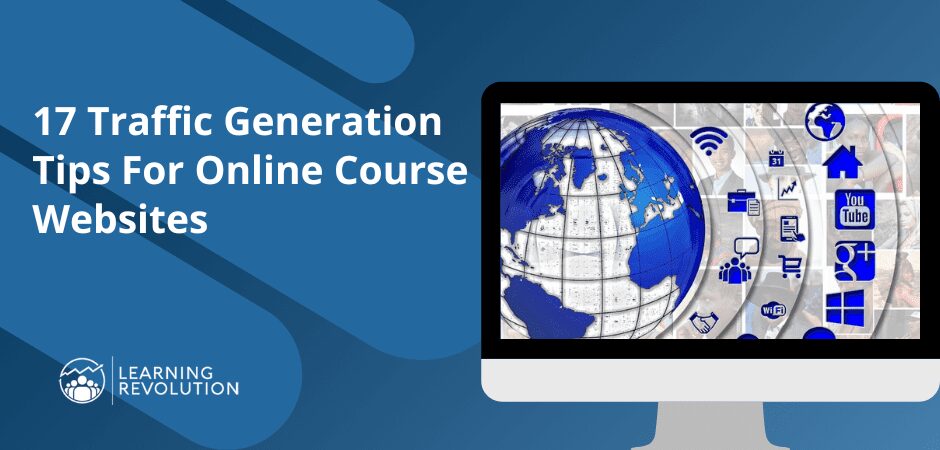


Extremely well written, in-depth, thorough article!
The term “masterclass” has become so overused and abused, with even FREE masterclass advertisements on Facebook… it’s almost as if every LIVE class (where the Trainer is actually interacting with participants), is being termed as a “masterclass”, irrespective of the level of expertise he has or the value he is offering to the participants. People read a book and then create a “masterclass” based on it, without actually implementing the contents of the book and getting results themselves.
Your article finally gave me clarity on this subject. The step-by-step sequence was an added bonus. Many thanks!
Very well written and easy to follow the steps in a logical process. Many course creators/educators make their information too complicated.
Thank you for putting this together and sharing your knowledge and experience.
Frankly, I see pretty much every online course these days labeled a masterclass, including a live webinar that is basically a slideshow with questions at the end, used to upsell an actual masterclass. Call me cynical but a “free masterclass” is an oxymoron.
I agree that the term is starting to be overused. If whatever the offering is doesn’t meet the criteria I cover under “Common Elements,” it isn’t a masterclass. Period. That said – and while understand your cynicism – I don’t agree that “free masterclass” is an oxymoron. There’s nothing about the nature of a masterclass that requires it to be a paid offering. It usually will be, of course – often one of the main reasons to offer a masterclass is that it provides a level of value that a creator is able to charge / charge more for – but again, so long as it is meeting the criteria around expertise, audience, narrow focus, etc., it is a masterclass regardless of what it costs.
Thanks. Glad you thought so!
Great article and valuable tips. Thank you for sharing.
Kind regards,
Kimberley